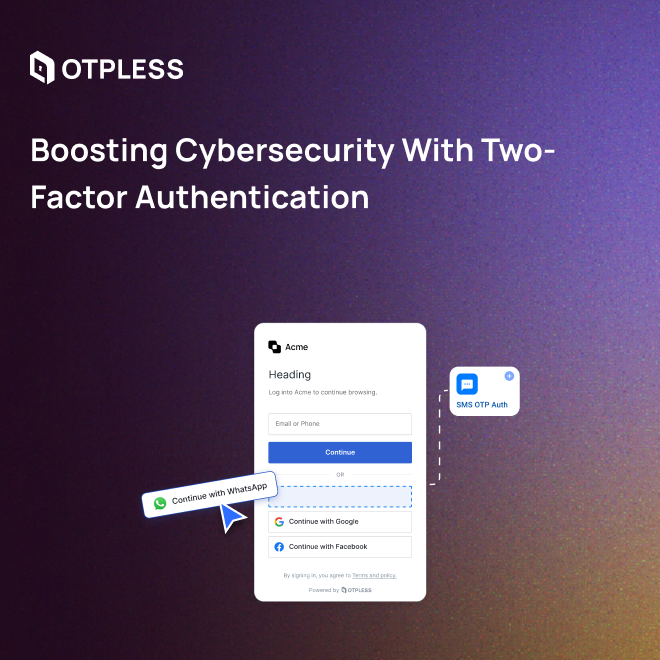Introduction
The digital age has ushered in unparalleled convenience and connectivity, transforming how we work, communicate, and manage our lives. However, this digital revolution also presents a significant challenge: the ever-present threat of cyber attacks. As our reliance on digital platforms grows, so does the sophistication of attacks aimed at stealing sensitive information. Traditional security measures, such as passwords, have proven insufficient on their own, as they can be easily compromised through techniques like phishing, social engineering, or brute force attacks.
Enter Two-Factor Authentication (2FA), a security process that adds an extra layer of protection to the standard password method of online identification. By requiring two distinct forms of identification before granting access to an account or system, 2FA drastically reduces the likelihood of unauthorized access, even if a password is stolen. This blog aims to explore the workings of 2FA, shed light on its benefits, and discuss its crucial role in bolstering cybersecurity efforts across the globe.
How 2FA Works
Two-factor authentication (2FA) is predicated on the principle that providing two disparate forms of identification offers significantly more security than just one. Typically, 2FA combines something you know (like a password or PIN) with something you have (such as a smartphone or a hardware token) or something you are (biometric data such as fingerprints or facial recognition). This dual-factor requirement ensures that even if an attacker compromises one factor, the chances of them having access to the second factor are slim, thereby preventing unauthorized access.
The process of 2FA usually follows these steps:
- The user enters their username and password, as they normally would.
- The site or application then requests the second factor, which could be a code generated by an app on the user’s smartphone, a text message sent to their phone, or a biometric reading.
- The user provides the second factor, and only then are they granted access.
This method effectively combines something you know (the password) with something you have or are, creating a robust defense against unauthorized access.

Benefits of 2FA
The benefits of Two-Factor Authentication extend far beyond just an added layer of security. Here’s a deeper look at how 2FA can transform cybersecurity:
- Enhanced Security: 2FA significantly lowers the risk of unauthorized access by adding a dynamic component (the second factor) that is much harder for attackers to obtain or replicate.
- Mitigation of Phishing and Social Engineering Attacks: Since the second factor of authentication is usually something physical or biometric, phishing attempts to steal static passwords become less effective.
- Regulatory Compliance: Many industries face strict regulatory requirements for protecting sensitive data. Implementing 2FA can help organizations comply with these regulations, avoiding fines and reputational damage.
- Increased Trust and Confidence: Customers and users are increasingly aware of cybersecurity issues. Implementing 2FA can enhance the trustworthiness of a platform, as it demonstrates a commitment to protecting user data.
Each of these benefits plays a crucial role in building a more secure and trustworthy digital environment for both organizations and individuals.

Implementing 2FA
The implementation of 2FA should be approached with careful consideration to ensure both security and user-friendliness. Here are some best practices:
- Select Appropriate Authentication Factors: Consider the balance between security and convenience. Options include SMS codes, authentication apps, email verification, voice calls, and biometric verification.
- User Education and Support: Implement comprehensive education campaigns to explain the importance of 2FA and provide clear instructions on how to use it. Support should be readily available for users who encounter issues.
- Integration with Existing Systems: Ensure that the 2FA solution integrates seamlessly with existing security systems and workflows without introducing significant friction or complexity.
Challenges and Solutions
Adopting 2FA can present several challenges, including resistance from users who may find it inconvenient, integration difficulties with existing systems, and the need to support a variety of devices and platforms. Overcoming these challenges requires a strategic approach:
- Minimizing User Friction: Opt for 2FA methods that provide a balance of security and ease of use. Solutions like push notifications for authentication can offer one-tap approvals, reducing inconvenience.
- Technical Integration: Work closely with IT and cybersecurity teams to ensure that the 2FA system is compatible with existing infrastructure. Consider cloud-based 2FA solutions for easier integration and scalability.
- Supporting Diverse Devices: Ensure that your 2FA solution supports a wide range of devices and platforms, accommodating all users.
Conclusion
Two-factor authentication is a critical tool in the cybersecurity arsenal. By requiring a second form of verification, it provides a robust defense against a variety of cyber threats. While challenges exist, the benefits of 2FA in enhancing security, compliance, and user trust far outweigh the potential hurdles. As cyber threats continue to evolve, adopting 2FA is not just recommended; it’s essential for protecting sensitive information in the digital age.
How OTPLESS Can Help Achieve Your Authentication Goals
OTPLESS specializes in providing advanced 2FA solutions that integrate seamlessly with your existing systems, offering a user-friendly and Secure authentication experience. Whether you’re looking to comply with regulatory standards, enhance data security, or simply build user trust, OTPLESS can help you achieve your authentication goals with its robust 2FA solutions.

